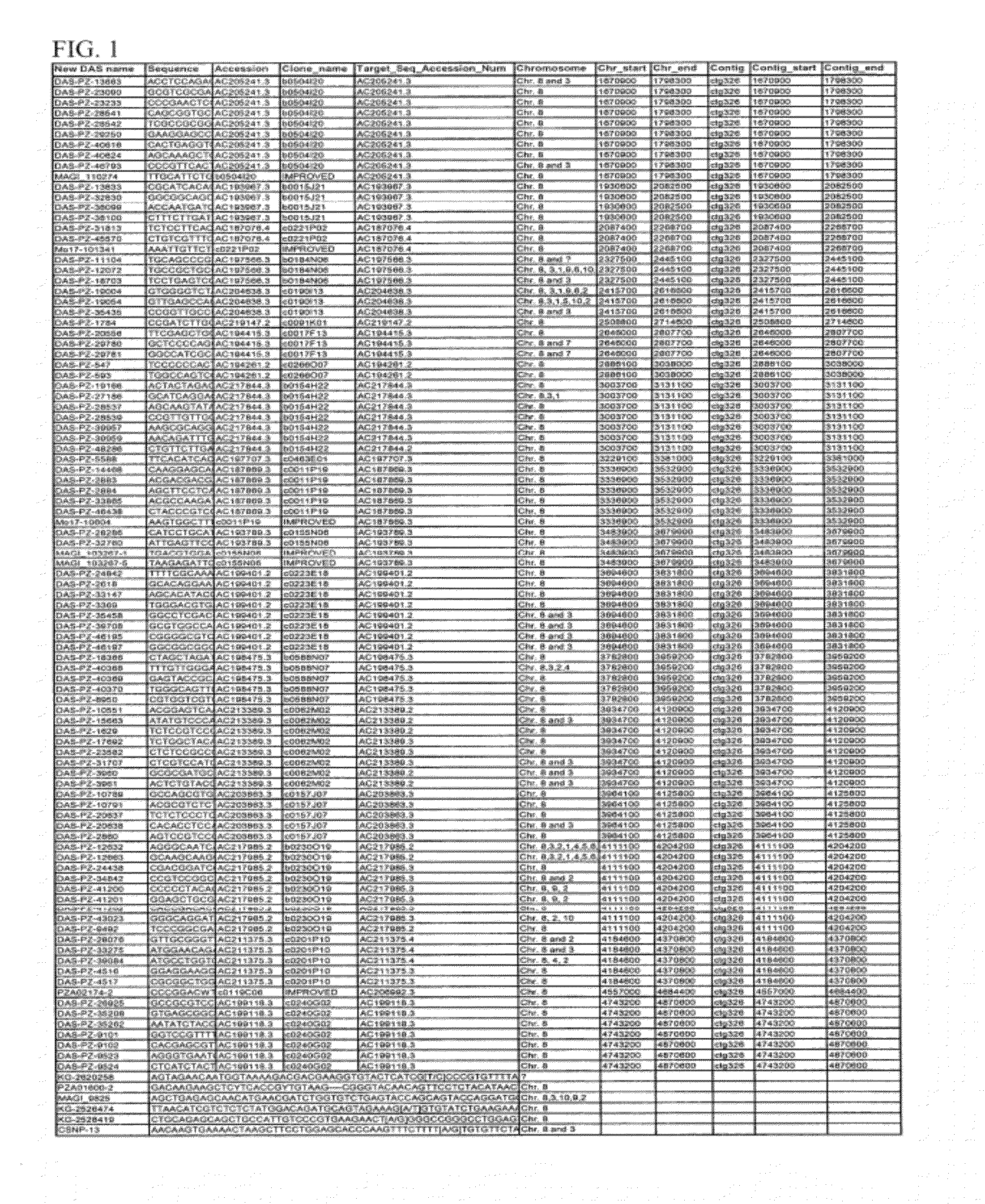Maize cytoplasmic male sterility (CMS) c-type restorer rf4 gene, molecular markers and their use
a cytoplasmic male sterility and restorer technology, applied in the field of plant fertility genes, can solve the problems of high labor intensity and cost, high cost of manual detasseling, and high risk of germplasm security, and achieve the effect of increasing seed yield and cost saving
- Summary
- Abstract
- Description
- Claims
- Application Information
AI Technical Summary
Benefits of technology
Problems solved by technology
Method used
Image
Examples
example 1
Materials and Methods
[0137]Validation Population.
[0138]A male sterile line of CMS-C type, BE4207, and a male sterile restorer line responding to CMS-C type, XJH58, were used as parents to generate F1 progeny. The F1 progeny where then selfed to generate an F2 population. The F2 population, consisting of 500 individuals, was used for identification of the Rf4 gene and markers linked (e.g., linked; tightly linked; or extremely tightly linked) to the Rf4 gene.
[0139]Fine mapping BE4207 / XJH58 F3 Population
[0140]A total of 5465 seeds selected from 15 heterozygous F2 families from the validation F2 population segregating for different fragments within the 4.2-Mb region on top of chromosome 8 were planted in a 2010 summer nursery in Arlington, Wis. Leaf samples were collected from 5104 germinated seedlings for genotyping.
[0141]Fertility Classification.
[0142]The 500 plants in this F2 population were phenotypically classified according to pollen shed from the tassels. Plants that shed pollen ...
example 2
Mapping of the Rf4Gene
[0150]Fertility Segregation Analysis.
[0151]The ratio of fertility segregation in the F2 population was 3:1. Table 1. The results demonstrated that fertility restoration in the CMS-C / Rf4 system is controlled by one dominant restorer gene, Rf4.
TABLE 1Phenotype data from the validation population.FertileSterileNo TasselTotal3731261500
[0152]Preliminary genetic mapping of Rf4 in the F2 population using SNP markers.
[0153]101 SNP markers located near the top of maize chromosome 8 were used in parental screening with 5 different Rf4 mapping populations, and were determined to be within the 5.0-Mb Rf4 region. A set of 12 markers were polymorphic in all five populations, whereas 27, including the 12 common polymorphic markers, showed polymorphism between parents of the BE4207×XJH58 F2 population. The 12 common markers were initially used to genotype all 500 individuals in the F2 population to identify recombinant lines within the 5.0 Mb region. The remaining 15 polymorph...
example 3
Fine Mapping of the Rf4Gene
[0159]A large BE4207 / XJH58 F3 fine mapping population of 5,104 individuals derived from the recombinant lines described above was generated.
[0160]In the F2 population, Rf4 was mapped to a region of less than 100 kb on top of chromosome 8. However, there are no existing molecular markers within this region except PZE-108000086, with a SNP at nucleotide position 98468. Two approaches were carried out to identify polymorphisms for additional markers within this interval. In the first approach, a NimbleGen™ (Roche Inc.) Sequence Capture experiment (Fu et al. (2010) Plant J. 62:898-909) was designed to capture all polymorphisms around the 6.0-Mb region on the top of chromosome 8 between the CMS line BE4207 and the restorer line XJH58, together with two additional restorer lines BE9515 and MLW03. Sequence capturing, sequencing of the captured targets, and SNP calling were performed by NimbleGen™ according to the manufacturer's recommended procedure. In tandem wi...
PUM
| Property | Measurement | Unit |
|---|---|---|
| concentration | aaaaa | aaaaa |
| emission wavelength | aaaaa | aaaaa |
| excitation wavelength | aaaaa | aaaaa |
Abstract
Description
Claims
Application Information
 Login to View More
Login to View More - R&D
- Intellectual Property
- Life Sciences
- Materials
- Tech Scout
- Unparalleled Data Quality
- Higher Quality Content
- 60% Fewer Hallucinations
Browse by: Latest US Patents, China's latest patents, Technical Efficacy Thesaurus, Application Domain, Technology Topic, Popular Technical Reports.
© 2025 PatSnap. All rights reserved.Legal|Privacy policy|Modern Slavery Act Transparency Statement|Sitemap|About US| Contact US: help@patsnap.com



